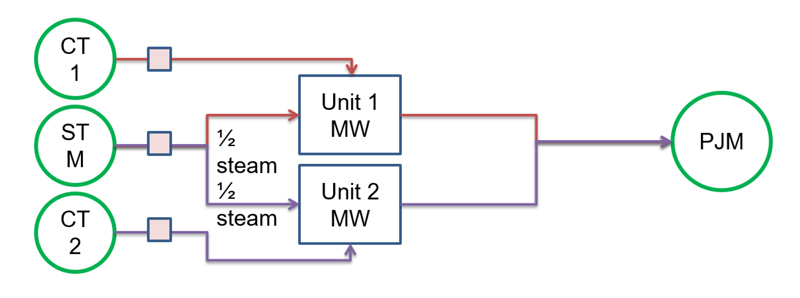Max Emergency Changes
Stakeholders expressed concerns at last week’s Markets and Reliability Committee meeting over a PJM plan to address the extension of a temporary change to maximum emergency status for gas combustion turbines and steam generators.
Chris Pilong, of PJM’s operations planning department, reviewed proposed revisions to Manual 13: Emergency Operations in a problem statement and issue charge. To address concerns with fuel security and new emission standards in states that emerged in recent months, Pilong said, PJM made a temporary change to section 6.4 of Manual 13 in a “note” to modify the remaining hours under which a resource may be offered as maximum emergency generation.
 Chris Pilong, PJM | © RTO Insider LLC
Chris Pilong, PJM | © RTO Insider LLCThe changes, which were endorsed in October, state that PJM may request a generation owner to move steam units, which are mostly coal-fired, into the maximum emergency category if their remaining run time falls below 240 hours, or 10 days. The units could be restricted from operating during that time unless required to meet reliability needs for the grid. (See Global Fuel Supply Prompts PJM Manual Changes.)
Units could remain in maximum emergency status until their fuel inventory rose above 21 days, or 504 hours, Pilong said, and the designation would only be implemented to address concerns with local or regional reliability resulting from fuel supply shortages. The previous run-hour threshold for maximum emergency was 32 hours.
Pilong said the manual change is set to expire April 1, but it needs to be extended to give PJM and stakeholders more time to work on a permanent solution. Additional work is being requested to take place under a new problem statement and issue charge titled “Max Emergency Changes for Resource Limitations.”
The issue charge calls for reviewing and modifying existing rules in response to concerns with the fuel and non-fuel supply chain, as well as the increasing environmental restrictions on generators that are creating challenges with managing run hours. Pilong said PJM wants to spend four months working on the issue in the Operating Committee and have a solution in advance of the summer 2022 peak period.
 Susan Bruce, PJM ICC | © RTO Insider LLC
Susan Bruce, PJM ICC | © RTO Insider LLC“We want to allow PJM and stakeholders to take a step back and take a more detailed look at Manual 13 and make sure we have the right changes and have those discussions,” Pilong said.
Susan Bruce, counsel to the PJM Industrial Customer Coalition (ICC), said she was concerned over what units the rules will apply to. It will be important for PJM and stakeholders to “take a big picture view” in discussions for any changes, she said.
“There are some really big issues that are going to be within this work effort that have implications for the nature of capacity,” Bruce said. “We don’t want to make decisions here that have ramifications in other places or that the work goes by the wayside because of efforts in other task forces.”
Independent Market Monitor Joe Bowring said stakeholders should keep in mind scenarios in which a lack of fuel or other consumables resulted from contractual issues that were theoretically controllable by the generation owner and how those situations should be treated differently compared to supply chain issues.
 PJM Monitor Joe Bowring | © RTO Insider LLC
PJM Monitor Joe Bowring | © RTO Insider LLCBowring also requested clarification of what PJM intends to include in the definition of “running for reliability” in the issue charge.
Pilong indicated that PJM will respond to the requests.
John Rohrbach, representing Southern Maryland Electric Cooperative, said resources following PJM’s dispatch while also trying to preserve themselves for a reliability event and reserve run hours could experience a “conundrum” through the language in the issue charge.
“It can create a challenge for a resource to guess when there’s going to be an event and to take itself out to procure fuel in advance of a switching event,” Rohrbach said.
Pilong said Rohrbach’s point is included in the expected deliverables of the issue charge for education on existing tariff language regarding unit eligibility and any practices and analysis for scheduling resources in max emergency.
Stakeholders will vote on the issue charges at the March 23 MRC meeting.
CCSTF Sunset
Melissa Pilong of PJM presented a first read of the Capacity Capability Senior Task Force’s (CCSTF) sunset. Pilong also presented the final report of the task force’s work completed.
The task force was originally created in March 2020 to consider using effective load-carrying capability (ELCC) to set the capacity value of limited-duration resources such as battery storage.
Stakeholders ultimately endorsed a joint proposal in September 2020 to use the ELCC method to calculate the capacity value of limited-duration, intermittent and combination (limited-duration plus intermittent) resources. FERC approved PJM’s proposal in August. (See FERC Accepts PJM ELCC Tariff Revisions.)
Pilong said work originally endorsed by stakeholders for a second phase of discussions has been moved to the Resource Adequacy Senior Task Force. The additional work includes a discussion of other rules or rule changes that may be necessary for limited-duration resources to participate in energy and ancillary service markets.
“It just made sense with all of the work that paralleled a lot of the efforts,” Pilong said.
The committee will be asked to endorse the task force sunset at its March meeting.
Minimum Run Time Guidance
Tom Hauske, principal engineer in PJM’s performance compliance department, reviewed a proposal that includes adding language to Manual 11: Energy and Ancillary Services Market Operations to address pseudo-modeled combined cycle minimum run time guidance.
 Example of a pseudo-modeled combined-cycle unit. | PJM
Example of a pseudo-modeled combined-cycle unit. | PJMHauske said market sellers can model a combined cycle generation unit as multiple “pseudo units” that are made up of a single combustion turbine and a portion of a steam turbine. But he said the potential exists for one or more of the pseudo-modeled units to operate for a period beyond the minimum run time parameter limit compared to an identical non-pseudo-modeled combined cycle unit if the market units of a pseudo-modeled combined cycle unit are dispatched at different times because the steam turbine takes extra time to reach operative levels.
Hauske said the proposed solution calls for adding language to Manual 11 to require market sellers to update the minimum run time of any subsequent pseudo-modeled unit to remove the associated steam turbine start-up time included in the parameter limit when it’s dispatched.
PJM removed language calling for “hourly” updates of the minimum run time parameter in order to avoid creating a “compliance trap” for market sellers who have several pseudo-modeled combined cycle units.
Hauske said PJM wants to have a final endorsement by the March 23 MRC meeting because the RTO’s unit-specific parameter adjustment process started Monday. PJM must provide a determination on the requests by April 15.
PJM will provide guidance developed in the initiative to any pseudo-modeled combined cycle unit requesting an adjustment the review period, Hauske said, or to existing pseudo-modeled combined cycle units with an approved unit-specific minimum run time parameter.
Manual 18 Revisions
Jeff Bastian, senior consultant in PJM’s market operations department, provided a first read of revisions to Manual 18: PJM Capacity Market to conform with several recent FERC orders. The changes from the orders included:
- revisions to the application of the minimum offer price rule, which became effective by operation of law in September when the commission deadlocked (ER21-2582);
- an October compliance filing to amend several sections of Attachment DD of the tariff establishing a replacement market seller offer cap (EL19-47);
- restored tariff provisions restoring the prior backward-looking energy and ancillary services (E&AS) offset for the 2023/24 Base Residual Auction and beyond (EL19-58); and
- the removal of the 10% cost adder for the reference resource used to establish the variable resource requirement curve (ER19-105).
Jeff Bastian, PJM
” data-credit=”© RTO Insider LLC” data-id=”8009″ style=”display: block; float: none; vertical-align: top; margin: 5px auto; text-align: right; width: 200px;” alt=”Bastian-Jeff-2019-03-06-RTO-Insider-FI” data-uuid=”YTAtNTUxNzU=” align=”right”>Jeff Bastian, PJM | © RTO Insider LLC
Bastian said language in section 3.3.2 was updated to reflect that the net E&AS of the reference resource combustion turbine will be calculated using the forward-looking methodology with application of the 10% adder for only the 2022/23 delivery year. The net E&AS will be determined using the historical approach and without application of the 10% adder for all other delivery years.
The revisions also delete language in section 5.4.5.2 describing the consequences of accepting a state subsidy after electing the competitive exemption or certifying that a resource is not state-subsidized.
“These are all conforming changes and the changes are all to be made effective with the 2023/24 BRA, which is scheduled to be conducted very shortly,” Bastian said.
A final vote on the changes is scheduled for the March 23 MRC meeting.
Manual First Reads
PJM staff presented several manual changes resulting from the periodic review for first reads. They included:
- Manual 12: Balancing Operations with a review of the language that included changes to attachment references and other minor revisions.
- Manual 13: Emergency Operations with a review of the language that added columns with winter values for estimated peak load and estimated load reduction in the voltage reduction summary table.
- Manual 37: Reliability Coordination with a review of the language that corrected Silver Run Electric to properly show as a transmission owner in Attachment A of the manual.
MRC Consent Agenda
Members unanimously endorsed two manual revisions as part of the MRC consent agenda, the only voting items at the meeting. They included:
- conforming revisions to Manual 27: Open Access Transmission Tariff Accounting related to a recent FERC order in response to industrial customers’ protest of PJM’s proposed revisions to its administrative rates. The revisions included reorganized wording to distinguish between administrative rates and pass-through rates, and a new section to only be reconciliation for transmission owner scheduling system control and dispatch service.
- revisions to Manual 40: Training and Certification Requirements resulting from the periodic review. The change included the addition of Maureen Curley as manager of PJM’s state and member training department. Curley replaced Michael Sitarchyk who retired as manager earlier this year.
MC Consent Agenda
Stakeholders unanimously endorsed one set of revisions clarifying fuel-cost policy standards in Manual 15 and Schedule 2 penalty language of the Operating Agreement as part of the consent agenda at last week’s Members Committee meeting.
The changes require that generation unit market sellers verify that all intraday offer triggers are specified in the unit’s fuel-cost policy. The Manual 15 updates include changes to the intraday update triggers. Fuel-cost policies will require providing a fuel price that can be calculated by the Monitor or PJM “after the fact with the same data available to the generation owner at the time the decision was made and documentation for that data from a public or a private source.”
The proposal was endorsed at the January MRC meeting and will take effect upon approval by the PJM Board of Managers and FERC. (See “Fuel-cost Policy Standard Clarifications Endorsed,” PJM MRC/MC Briefs: Jan. 26, 2022.)


